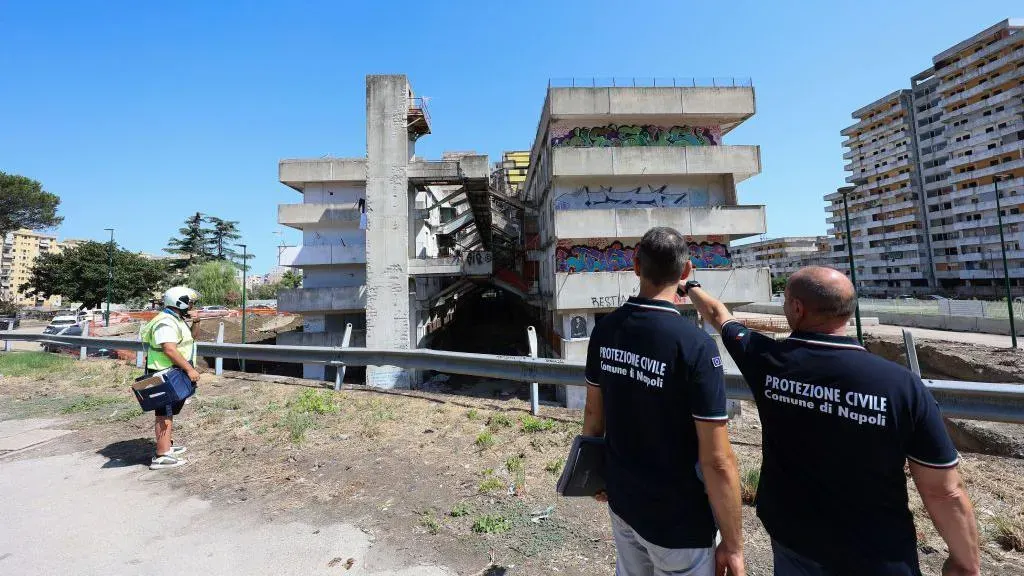Overview of the Incident
On a sweltering night in Naples, a devastating tragedy unfolded when a walkway on the notorious Scampia estate collapsed, leading to the death of two people and injuring 13 others. This collapse, which occurred on a third-floor walkway connecting two sections of a dilapidated building, has highlighted not only the dire state of the estate but also the broader issues surrounding urban decay and inadequate infrastructure.
The Collapse: Eyewitness Accounts and Immediate Impact
The Incident
The collapse occurred late at night, during what should have been a peaceful evening for residents seeking respite from the intense heat. Vincenza Troise, a local resident, described the harrowing moment as a sudden and violent upheaval. “We were having dinner with the door wide open because it was so hot when suddenly we heard a loud roar, like an earthquake,” Troise recounted.

Victims and Injuries
The tragedy claimed the lives of Roberto, a 29-year-old butcher, and his 35-year-old aunt Margherita, a mother of three. Roberto was described as a loving father to a two-year-old girl, while Margherita was the devoted mother of three children. The collapse resulted in injuries to 13 people, including seven children aged between two and eight years old. The condition of two of these younger children is critical, adding to the gravity of the situation.
Emergency Response
In the immediate aftermath, more than 800 residents were evacuated from the estate as a precautionary measure. The prompt action of emergency services and local authorities helped mitigate further casualties and provided urgent care to the injured.
The Scampia Estate: A Symbol of Urban Decay
Historical Background
The Scampia estate, located to the north of Naples, was originally constructed in the 1960s during Italy’s postwar economic boom. Designed by modernist architects inspired by Le Corbusier’s housing concepts, the estate was intended to accommodate Naples’ rapidly growing population. The complex, consisting of seven large buildings known as “Vele” or “sails” due to their triangular shape, was envisioned as a vibrant community with green spaces, schools, and playgrounds.
Decline and Issues
However, the estate quickly fell into disrepair. The promised amenities, including green spaces and public transport connections, never materialized. Over time, Scampia became synonymous with urban decline, becoming a hotspot for organized crime, drug dealing, and prostitution. The area’s deterioration was exacerbated by the influx of families displaced by the 1980 earthquake, leading to overcrowding and worsening unsafe living conditions.
The Role of Organized Crime and Cultural Efforts
Criminal Activity
The estate’s infamy was cemented by the violent criminal activities that plagued the area. In the early 2000s, Roberto Saviano’s book Gomorrah and its subsequent film adaptation brought global attention to the region’s issues, depicting the bloody gang feuds and lawlessness that characterized Scampia.

Community Initiatives
Despite the pervasive criminal influence, many residents and local organizations have worked tirelessly to improve conditions and foster a sense of community. Grassroots cultural initiatives and community projects aimed at keeping children away from gangs have been pivotal in attempting to shift the narrative and uplift the neighborhood.
Ongoing Renovation and Future Plans
Demolition and Redevelopment
Since 1998, efforts have been underway to demolish the deteriorating “Sails” of Scampia. However, these efforts have frequently been stalled due to the discovery of asbestos. Progress has been made with the construction of a university campus on the site of one of the demolished “Sails,” and plans for a new kindergarten, cultural center, and park are in development.
The Last “Sail”
As of the end of this year, only one building, the Vela Celeste (Blue Sail), remains standing. This building, where the recent tragedy occurred, is scheduled to be repurposed into office space. The city of Naples has stated that the remaining “Sail” will serve as a symbolic reminder of the past, the neighborhood’s struggles, and the ongoing fight for redemption.
Official Reactions and Next Steps
Government Response
Italian Prime Minister Giorgia Meloni expressed her distress over the incident and extended condolences to the victims’ families. The local authorities, including the mayor of Naples, Gaetano Manfredi, have emphasized their commitment to continue the redevelopment efforts despite the tragedy.
Legal and Investigative Actions
Prosecutors in Naples have launched an investigation into the collapse, focusing on potential manslaughter charges. The ongoing investigation aims to uncover any negligence or malfeasance that may have contributed to the structural failure.
Reflections and Moving Forward
Impact on the Community
The collapse has underscored the critical need for continued attention to the conditions in Scampia. The tragedy serves as a stark reminder of the urgent need for comprehensive urban redevelopment and infrastructure improvements.
Hope for the Future
Despite the setbacks, there is a collective hope for a brighter future for Scampia. The commitment to redeveloping the estate and addressing its historical issues reflects a broader effort to create a safer, more vibrant community for its residents.
In summary, the tragic walkway collapse in Scampia not only highlights the immediate loss and suffering experienced by the residents but also serves as a catalyst for renewed focus on the longstanding issues affecting the estate. The response from local and national authorities, combined with the ongoing redevelopment efforts, reflects a concerted effort to address the challenges and work towards a more hopeful future for this historically troubled neighborhood.


